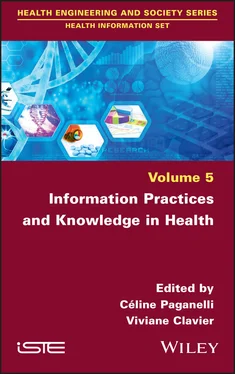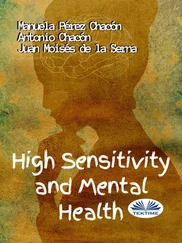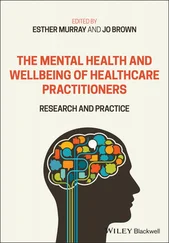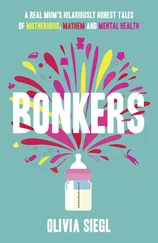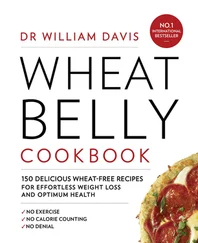1 Cover
2 Title Page Health Information Set coordinated by Céline Paganelli and Viviane Clavier Volume 5
3 Copyright First published 2022 in Great Britain and the United States by ISTE Ltd and John Wiley & Sons, Inc. Apart from any fair dealing for the purposes of research or private study, or criticism or review, as permitted under the Copyright, Designs and Patents Act 1988, this publication may only be reproduced, stored or transmitted, in any form or by any means, with the prior permission in writing of the publishers, or in the case of reprographic reproduction in accordance with the terms and licenses issued by the CLA. Enquiries concerning reproduction outside these terms should be sent to the publishers at the undermentioned address: ISTE Ltd 27-37 St George’s Road London SW19 4EU UK www.iste.co.uk John Wiley & Sons, Inc. 111 River Street Hoboken, NJ 07030 USA www.wiley.com © ISTE Ltd 2022 The rights of Céline Paganelli and Viviane Clavier to be identified as the authors of this work have been asserted by them in accordance with the Copyright, Designs and Patents Act 1988. Any opinions, findings, and conclusions or recommendations expressed in this material are those of the author(s), contributor(s) or editor(s) and do not necessarily reflect the views of ISTE Group. Library of Congress Control Number: 2021949036 British Library Cataloguing-in-Publication Data A CIP record for this book is available from the British Library ISBN 978-1-78630-611-1
4 Introduction
5 1 Open Access as a Regulation of Scientific Information in Health
1.1. Introduction 1.2. The political anchoring of Open Access in the field of Health 1.3. Gold Open Access or the “Author-Pays” principle 1.4. Predatory journals: the “price” of change 1.5. The place and weight of funding agencies in the OA environment 1.6. Plan S, a “radicalization” 12of Open Access in Health? 1.7. Scientific information in Health: a world of no journals? 1.8. Conclusion 1.9. References
6 2 Knowledge Organization and Studies of Information Practices: Contribution to the Characterization of Health Information2.1. Introduction 2.2. Theoretical framework 2.3. Discourse collection and corpus analysis: approaches to health information from the “field” 2.4. Conclusion: towards a characterization of health information 2.5. References
7 3 Health Literacy in Complex Digital Information Environments3.1. Introduction 3.2. Analyzing health information on the Internet: the need for a mixed and comprehensive approach 3.3. Key findings and issues in digital health literacy 3.4. Health, information and digital technology: a logic in line with transliteracy 3.5. Conclusion 3.6. References
8 4 The Essential Role of Health Information Literacy in Seniors’ Healthcare Communication4.1. Introduction 4.2. Health information behavior of older adults 4.3. Literacies related to health 4.4. Literacies and older age 4.5. Health literacy and healthcare communication 4.6. Health information literacy and health information behavior 4.7. Measuring health information literacy 4.8. Communication between seniors and healthcare professionals 4.9. Health information literacy and healthcare communication 4.10. Conclusions 4.11. Appendix 1: standard regression results 4.12. References
9 5 Categorization of Audiences and Hierarchization of Actors in the Journalistic Narrative on HIV/AIDS Prevention. What Implications for Prevention Information?5.1. Introduction 5.2. Methodology 5.3. Routinized journalistic treatment of HIV/AIDS prevention 5.4. Categorizing users: between stigmatization and the need for prevention 5.5. From a categorization of the public based on membership in a risk group to a focus on practices 5.6. Media coverage of biomedical prevention actors 5.7. Conclusion 5.8. References
10 6 Historical Approach to Health Information in Anti-alcohol Prevention: The Case of the American National Prohibition Campaign (1910–1919)6.1. Introduction 6.2. Health information in the prohibitionist campaign 6.3. Communicating health information 6.4. Information and influence 6.5. Conclusion 6.6. References
11 7 Professional Uses of Specialized Information in Ophthalmology. Interview with Pascal Four, Doctor of Ophthalmology 7.1. Training and areas of intervention in ophthalmology 7.2. Information useful in the context of medical practice 7.3. Access to knowledge and information sources 7.4. Time spent searching for information, criteria for evaluating information 7.5. Information exchanged with patients 7.6. Knowledge organization and structuring of the document base 7.7. Appendix: interview grid
12 8 Organization of Medical Knowledge: Documentation Techniques Applied to a Macro-domain Underpinned by Socio-political Issues8.1. Introduction 8.2. Documentation and Library and Information Sciences and the organization of knowledge 8.3. Methodology 8.4. Presentation of the corpus of publications between 1960 and 2019 8.5. Medical knowledge organization systems 8.6. New challenges for indexing and information retrieval 8.7. Social, cultural, political and economic issues 8.8. Discussion 8.9. Conclusion 8.10. References 8.11. Appendix 1: the corpus of journal articles and conference proceedings 8.12. Appendix 2: MKOS corpus
13 List of Authors
14 Index
15 End User License Agreement
1 Cover
2 Table of Contents
3 Title Page Health Information Set coordinated by Céline Paganelli and Viviane Clavier Volume 5
4 Copyright First published 2022 in Great Britain and the United States by ISTE Ltd and John Wiley & Sons, Inc. Apart from any fair dealing for the purposes of research or private study, or criticism or review, as permitted under the Copyright, Designs and Patents Act 1988, this publication may only be reproduced, stored or transmitted, in any form or by any means, with the prior permission in writing of the publishers, or in the case of reprographic reproduction in accordance with the terms and licenses issued by the CLA. Enquiries concerning reproduction outside these terms should be sent to the publishers at the undermentioned address: ISTE Ltd 27-37 St George’s Road London SW19 4EU UK www.iste.co.uk John Wiley & Sons, Inc. 111 River Street Hoboken, NJ 07030 USA www.wiley.com © ISTE Ltd 2022 The rights of Céline Paganelli and Viviane Clavier to be identified as the authors of this work have been asserted by them in accordance with the Copyright, Designs and Patents Act 1988. Any opinions, findings, and conclusions or recommendations expressed in this material are those of the author(s), contributor(s) or editor(s) and do not necessarily reflect the views of ISTE Group. Library of Congress Control Number: 2021949036 British Library Cataloguing-in-Publication Data A CIP record for this book is available from the British Library ISBN 978-1-78630-611-1
5 Introduction
6 Begin Reading
7 List of Authors
8 Index
9 End User License Agreement
1 Chapter 6Figures 6.1 and 6.2. Pamphlet “Beer a food?” (Safety First) and Pamphlet 22 (STF...Figure 6.3. Modalities of evidence for health information Figure 6.4. Distribution of visual representations by type Figures 6.5 and 6.6. Pamphlet 9 (STF) and Pamphlet 2 (STF) Figure 6.7. Thematic classification of pamphlets by effect
1 Chapter 4Table 4.1. Socio-demographic background of the 281 respondents Table 4.2. Responses to statements on communication in a healthcare context (ada...
2 Chapter 6Table 6.1. Summary table of health themes Table 6.2. Identification of the Federation’s health information competencies Table 6.3. The rhetoric of error
Читать дальше
